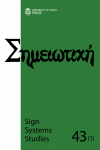(Religious) belief and atheism from a semiotic viewpoint
(Religious) belief and atheism from a semiotic viewpoint
Author(s): Peet LepikSubject(s): Semiotics / Semiology, Theology and Religion, Psycholinguistics
Published by: Tartu Ülikooli Kirjastus
Keywords: phenomenon of belief; religiosity; atheism; autocommunication; formal features of dedicational communication
Summary/Abstract: The article attempts to give a semiotic definition of the intellectual attributes of belief (in its broader sense), religious belief and atheism, treating all three of them as sign systems – cultural languages.To define the formal structure of the phenomenon of religion, five aspects of the corresponding communicative act should be considered – the orientational, the sign-creating, the cognitive, the teleological and the energetic ones. Belief as an orientational act cannot be treated without including autocommunication: the I-you relation is accompanied by the I-I relation in the form of vertical and horizontal topological imaginations. The sign creating aspect of belief is expressed, on the one hand, in the performative characteristics of utterances (utterance = act) and, on the other hand, in symbolic mnemonic programming. As a cognitive act, communication typical of belief is mythological, expressing identifi cation with the addressee and the subjective eternity of the relation. Teleologically, belief is connected with the existential projection; energetically we treat belief as energeia – the creative force of man. Relying on the Scriptures and theological literature (mainly the works of Paul Tillich), the article analyses the appearance of all these communicative characteristics in religious sign-creating.
Journal: Σημειωτκή - Sign Systems Studies
- Issue Year: 43/2015
- Issue No: 1
- Page Range: 48-76
- Page Count: 29
- Language: English

